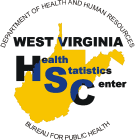
|
HSCStatistical BriefNumber 16February 2006 |

|
Asthma Among West Virginia Children, 2006
Asthma is a disease of the lungs characterized by inflammation of the air passages. During an asthma episode or attack, airways become blocked or narrowed causing tightness in the chest, difficulty breathing, wheezing, and coughing. There are many “triggers” that may initiate an asthma episode, including allergens, irritants in the air, respiratory infections, exercise, weather, strong emotional expressions, and some medications (1). Asthma symptoms can be controlled through medication and avoidance of identified triggers. However, poor management of the disease can lead to hospitalization and even death.
Asthma is the most common chronic disorder among children (2). In 2003, an estimated 6.2 million children in the United States under the age of 18 had asthma. It is the leading cause of school absenteeism (due to chronic conditions) and the third leading cause of hospitalization among children under the age of 15. In 2003, asthma accounted for an estimated 12.8 million lost school days among school-aged children (2) and 213,000 hospitalizations among children under the age of 15 (3). While deaths due to asthma are rare among the young, in 2002, 170 children under the age of 15 died as a result of asthma complications (4).
SURVEILLANCE.
Since 1997, national data on the prevalence and severity of asthma among children and adolescents have been collected primarily through the National Health Interview Survey. However, comparable state-level data did not exist before 2002. The WV Youth Tobacco Survey (YTS) collected information on asthma prevalence, asthma attacks, prescription medication use, and missed school days from WV public middle school (MS) students in 2002 and public high school (HS) students in 2002 and 2005. No state-sponsored survey has ever collected data on asthma among younger children.
In 2003, the U.S. Maternal and Child Health Bureau sponsored the National Survey of Children’s Health (NSCH) after identifying a lack of national and state-specific data on the health and well being of children under the age of 18. An adequate sample was collected in each of the 50 states and the District of Columbia to produce valid, reliable, and comparable state-level estimates. A total of 2,022 interviews were completed in West Virginia. The NSCH is scheduled to be repeated in 2007.
PREVALENCE
In 2003, the percentage of children who currently had asthma was significantly higher in WV than the nation as a whole (see Figure 1). According to the NSCH, more than 1 in 10 (11.1%) WV children under the age of 18 had asthma in 2003, compared with 8.9% of children in the US. This was the 4th highest prevalence in the country (among the 50 states and DC; range=5.7% to 11.9%). Only Delaware, Hawaii, and DC reported higher rates of current asthma in 2003.
The prevalence of lifetime asthma was significantly higher than current asthma in the US but not WV. According to the NSCH, 13.5% of WV children and 12.5% of US children in 2003 had ever been diagnosed with asthma by a doctor or health care professional (see Figure 1). Among the 50 states and DC, WV ranked 12th in the prevalence of lifetime asthma in 2003 (range=8.1% to 17.2%).
The prevalence of current asthma did not significantly differ by age in 2003 (NSCH). However, children under the age of five were significantly less likely to have ever been diagnosed with asthma (lifetime asthma) than older children (see Figure 2 ). This may be partly explained by the hesitance of some health professionals to provide an asthma diagnosis to this age group, due to complications in diagnosis among very young children (5). Although as adults, WV females are significantly more likely to have current asthma than males, the prevalence of asthma did not significantly differ by gender among WV children (according to NSCH and YTS data).
While YTS estimates of lifetime asthma1 among WV youth are higher than the NSCH (see Figures 2, 3), estimates of current asthma prevalence are consistent between the surveys. According to the YTS, approximately 13% of WV HS students currently have asthma (13.1% in 2002; 12.9% in 2005) (current asthma prevalence cannot be calculated for MS students). This is comparable to the 12.5% estimate among 14-to-17 year-olds in the NSCH. Between 2002 and 2005, the prevalence of lifetime and current asthma remained stable among WV HS students.



Not only were WV children significantly more likely to have current asthma than US children, they also had significantly higher rates of asthma than WV adults. In 2003, 11.1% of WV children currently had asthma, compared with 8.1% of WV adults (as measured by the WV Behavioral Risk Factor Survey). While the rates of current asthma did not differ between WV girls (0-17) and women (18+) in 2003 (10.7% versus 10.7%), WV boys had a significantly higher rate than WV men (11.5% versus 5.3%).
SYMPTOMS & DISEASE MANAGEMENT
Asthma is a variable disease. Symptoms of the disease differ among individuals, can vary within an individual by time of day and year, and can change throughout the life span. Uncontrolled asthma can lead to severe symptoms that result in missed school days, emergency room visits, hospital stays, and reduced quality of life.
Asthma attacks are the most common symptom measured by surveys. According to the NSCH and YTS, a majority of children with asthma had recently experienced an asthma attack. The NSCH indicates that 59.9% of WV children and 60.8% of US children with asthma in 2003 had experienced an attack within the 12 months prior to the survey. The YTS produced a similar estimate for WV HS students with current asthma (63.6% in 2002; 58.6% in 2005). Nearly half (48.5%) of WV MS students with lifetime asthma in 2002 reported an asthma episode within the past year.
More than one-third (37.5%) of children with current asthma in 2003 had taken prescription medication to manage their asthma within the day prior to the survey (NSCH; see Figures 4). The YTS asked students if they were currently taking prescription asthma medication. Nearly half (49.4%) of WV MS students with lifetime asthma in 2002 reported current medication use. Close to 40% of HS students with lifetime asthma (36.7% in 2002; 38.4% in 2005) and almost 60% with current asthma were currently taking prescription asthma medication (56.5% in 2002 and 58.5% in 2005).
Children with asthma were significantly more likely to miss school than children without asthma (see Figures 5). According to the NSCH, more than 9 out of 10 WV children (92.7%) with current asthma in 2003 missed school due to illness or injury within the 12 months prior to the survey, compared with 82.5% of children without asthma. Children with asthma were also significantly more likely to miss more than 5 days of school than those without asthma. More than one-fourth (26.4%) of WV children with asthma missed 6 to 10 days of school during the 12 months prior to the survey and nearly one-fifth (18.9%) missed 11 or more days. The YTS asked students about missed school days specifically due to asthma complications. Approximately 40% of WV MS students with lifetime asthma (39.9% in 2002) and HS students with current asthma (45.1% in 2002; 37.0% in 2005) missed one or more days of school due to asthma during the current school year.
Uncontrolled asthma can cause health problems that reduce quality of life. According to the NSCH, 8.1% of WV children with asthma experienced severe health difficulties as a result of the disease in 2003. In addition, the disease caused a “great deal of burden” in 3.2% of families with a child who currently has asthma. Ultimately, children with current asthma were significantly more likely to have fair or poor general health than children without asthma (see Figures 6).
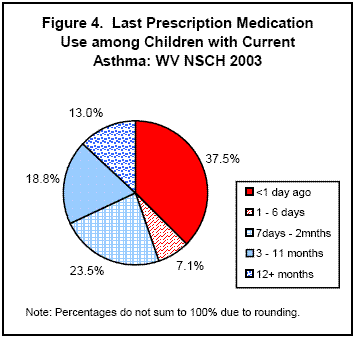
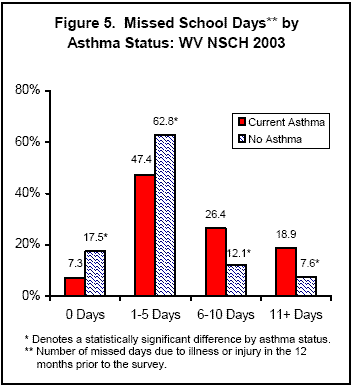
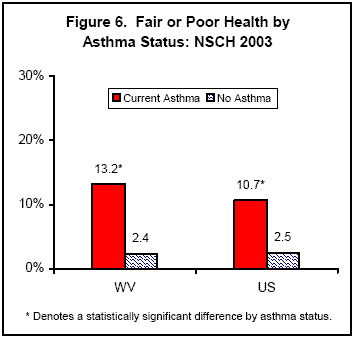
HOSPITALIZATIONS
Hospitalizations are a strong indicator of the burden of asthma because asthma hospitalizations are considered preventable. That is, with proper management of the disease, individuals with asthma should not need to be hospitalized due to asthma complications. Yet, asthma is the third leading cause of hospitalization among children in the nation (2). Ultimately, a reduction in asthma hospitalizations signals an increase in well-managed asthma and a decrease in the health and economic burdens of the disease.
According to the WV Health Care Authority (WVHCA)2, 3,471 hospitalizations with a primary diagnosis of asthma (ICD-9-CM 493) occurred among West Virginians (rate of 19.2 per 10,000) in 2003. Nearly one-fourth (24.3%) of these were among children under the age of 15 (845 hospitalizations). In the years 1996 through 2002, WV children had a higher rate of asthma hospitalizations than West Virginians aged 15-44, 45-64, and 65 and older.
WV children experienced a much lower rate of hospitalizations due to asthma than US children in the years 1996 through 2003 (see Figure 7). In 2003, the rate of asthma hospitalizations among WV children was 26.5 per 10,000, compared with 35.0 per 10,000 among children nationwide.
Asthma hospitalizations differed by age and sex among WV children. In the years 1996 to 2003, WV children under the age of 5 had asthma hospitalization rates 3 to 4 times higher than those aged 5 to 14 (see Figure 8). In every year from 1996 to 2003, WV females had a higher rate of asthma hospitalizations than males. For example, in 2003 WV females had an age-adjusted asthma hospitalization rate of 22.8 per 10,000, compared with a rate of 14.5 per 10,000 among males. However, in childhood males had a considerably higher rate than females (see Figure 9). In 2003, WV boys were hospitalized due to asthma complications at a rate almost twice that of girls (34.3 per 10,000 versus 18.3 per 10,000).
In 2003, WV children experienced the highest number (112) of asthma hospitalizations in September. When hospitalized with asthma complications, they spent an average of two days in the hospital. Hospitalization charges totaled nearly $3 million, with more than half (55.6%) of child hospitalizations charged to public health insurance programs such as Medicaid, WV Children’s Health Insurance Program (CHIP), and Medicare.
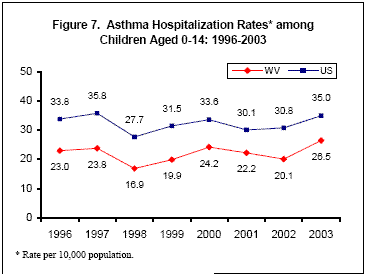
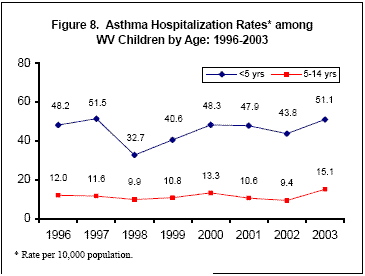
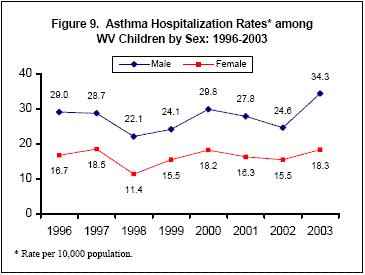
HEALTH CARE ACCESS & UTILIZATION
It is important for children with a chronic disease such as asthma to have access to adequate health care coverage and medical treatment. While children with asthma should receive routine medical exams, excessive use of emergency departments and high rates of hospitalization are an indication that a child’s asthma is not properly managed or controlled.
In 2003, WV children were significantly more likely to have health care coverage than US children (NSCH). According to the NSCH, 6.6% of WV children were uninsured in 2003, compared with 8.8% of children nationwide. The percentage of children without health insurance did not significantly differ by asthma status in WV (see Figure 10).
WV children were also significantly more likely to have public health care coverage (such as Medicaid or CHIP) than US children. More than one-third (37.2%) of WV children had public health insurance in 2003, compared with 27.7% of US children (NSCH). In addition, children with asthma were significantly more likely to have public health coverage than those without asthma (see Figure 10).
Overall, WV children were also more likely to have a personal doctor than US children. The NSCH defines a personal doctor as a health professional who knows the child well and is familiar with the child’s health history. In 2003, approximately 12% (12.4%) of WV children did not have a personal doctor, compared with nearly 17% (16.7%) of US children. In 2003, children with asthma were significantly more likely to have a personal doctor than those without asthma (WV: 94.6% versus 86.7%; US: 88.6% versus 82.8%).
There are four main types of medical care: preventive care3, sick care, emergency care, and hospitalization. The NSCH indicates that overall, WV children were significantly more likely to have had a preventive health visit in the 12 months prior to the survey than US children (82.1% versus 77.8%). However, there was no significant difference in the rate of preventive visits between WV and US children with asthma (85.8% versus 86.8%). Although US children with asthma were significantly more likely than those without asthma to have had a preventive visit, preventive visits did not differ significantly by asthma status in WV (see Figure 11).
Children in WV and the US with asthma were significantly more likely to have had a sick care visit and emergency room visit within the past year than those children without asthma (see Figure 11 for WV). In addition, children with asthma were significantly more likely to have experienced multiple visits. The NSCH indicates that the percentage of children who had six or more sick care visits in the year prior to the survey was more than three times higher among WV children with asthma than those without asthma (24.1% versus 6.7%, respectively). More than one-fifth (23.9%) of WV children with asthma in 2003 had two or more emergency room visits within the 12 months prior to the survey, compared with 8.3% of children without asthma.


CONCLUSION
Asthma is the most common chronic condition among children in the United States, and in 2003 West Virginia had the 4th highest rate of childhood asthma in the nation (among the 50 states and D.C.) Approximately 11% of WV children currently had asthma, a significantly higher rate than US children (8.9%). Poor management of the disease can lead to complications resulting in hospitalization or even death.
Data from the NSCH and YTS showed that a majority of WV children with asthma had experienced an asthma attack within the year prior to the survey. In addition, they were more likely than children without asthma to 1) miss school, 2) have fair or poor health, 3) experience sick care and emergency room visits, and 4) have public health care coverage. On a positive note, WV children with asthma were more likely to have a personal doctor than those without asthma.
Although WV children were significantly more likely to have asthma than children nationwide, the rate of asthma hospitalizations among children was lower in WV than the US in the years 1996 through 2003. Overall, WV children (aged 0-14) had a higher rate of asthma hospitalizations than adults, and younger children (aged 0-4) had a considerably higher rate than older children (aged 5-14). While WV boys were no more likely to have asthma than girls, they had a dramatically higher rate of hospitalization due to asthma complications.
In 2004, the WV Asthma Education and Prevention Program (WV-AEPP), housed within the Bureau for Public Health and funded by the Centers for Disease Control and Prevention (CDC), began implementing asthma management and environmental trigger programs in schools across the state. In collaboration with the American Lung Association of West Virginia, WV-AEPP formed the West Virginia Asthma Coalition (WVAC). WVAC comprises individuals and organizations interested in reducing the burden of asthma in the state. WVAC members meet multiple times a year to collaborate and work on projects aimed at ensuring quality health care, promoting healthy trigger-free environments, identifying and addressing needs of children with asthma, and distributing information about the disease. For additional information about childhood asthma, WV-AEPP programs, or the WVAC, visit the WV-AEPP (http://www.wvdhhr.org/bph/oehp/asthma/default.htm) or WVAC (http://www.alawv.org/WVAC_folder/WVAC.htm) websites.
REFERENCES
- Asthma and Allergy Foundation of America. Asthma Overview: What Causes Asthma. Online.
< http://www.aafa.org/display.cfm?id=8&cont=6 >. - American Lung Association. Asthma & Children Fact Sheet. July 2005. Online.
< http://www.lungusa.org/site/pp.asp?c=dvLUK9O0E&b=44352 >. - DeFrances CJ, Hall MJ, Podgomik MN. 2003 National Hospital Discharge Survey. Advance data from vital and health statistics; no 359. Hyattsville, MD: National Center for Health Statistics. 2005. (Table 2).
- Kochanek KD, Murphy SL, Anderson RN, Scott C. Deaths: Final Data for 2002. National vital statistics reports; vol 53 no 5. Hyattsville, MD: National Center for Health Statistics. 2004. (Table 10).
- National Initiative for Children’s Healthcare Quality. Asthma Resources for Providers:
Tips for the Diagnosis of Asthma in Children Under 5. Online.
< http://www.nichq.org/NICHQ/ >.
ADDITIONAL RESOURCES
- National Hospital Discharge Survey: Annual Summary with Detailed Diagnosis and Procedure Data. National Center for Health Statistics. (1996-2002).
- National Survey of Children’s Health, 2003. Sponsored by the US Department of Health and Human Services, Maternal and Child Health Bureau.
- WV Behavioral Risk Factor Survey, 2003. Sponsored by the Centers for Disease Control and Prevention. Conducted by the WV Health Statistics Center.
- WV Youth Tobacco Survey 2002, 2005. Sponsored by the WV Division of Tobacco Prevention and the WV Department of Education.
FOOTNOTES
1Due to differences in YTS survey questions, lifetime asthma is defined differently for middle school and high school students. Middle school: ever diagnosed with asthma by a doctor; High school: ever diagnosed with asthma by a doctor or other health care professional.
2 The WVHCA collects hospital discharge data from all non-federal licensed hospitals in the state. National hospital discharge rates are calculated from the National Hospital Discharge Survey.
3Preventive medical care refers to routine doctor visits such as physical exams or well-child check-ups.
Supported by the Cooperative Agreement number U59/CCU324180 from the Centers for Disease Control and Prevention. Its contents are solely the responsibility of the authors and do not necessarily represent the official views of the Centers for Disease Control and Prevention.
Produced in collaboration with the West Virginia Asthma Coalition.
If you have questions concerning the content of this page, please contact Amy Wenmoth at (304) 558-9100 or Amy.B.Wenmoth@wv.gov.
| WV | DHHR | BPH | OEHP | HSC | Top of Page |